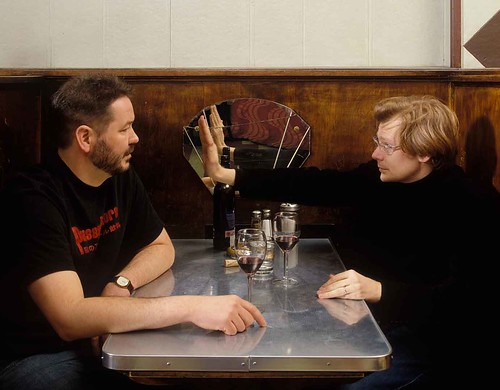After eight years in Minneapolis, Vergne will be leaving in a few days to become the director of the new François Pinault Foundation for Contemporary Art in Paris (or Venice, the location is still up in the air). On the occasion of his departure, I sat in on an interview between Vergne and Minneapolis artist Todd Norsten as they discussed, among other topics, Vergne's role as co-curator (with the Whitney's Chrissie Iles) of the 2006 Whitney Biennial. A few excerpts from the conversation, which is available as a pdf at Frenchculture.org, gives a hint why I'll be missing his thinking 'round these parts:
Todd Norsten: Do you think art can change the world?Above: Minneapolis artist and Walker curator Philippe Vergne. Photo: Cameron Wittig
Philippe Vergne: Yes. I want to believe it’s like the butterfly flapping its wings in Minnesota and creating a hurricane in Ulaanbaatar. And if it’s not true, well, I’ll still believe it’s a viable idea. Art provides a social contract—with audiences, with artists, with content, whether it’s coming from visual art or music or philosophy or films—that doesn’t find an obvious channel in everyday life. An art center provides a venue for something that won’t be on television, won’t be carried by major music distributors. Look at [Ellsworth] Kelly’s work. It’s tough. What justifies Kelly in a culture informed by the market, by entertainment, by a logic of efficiency? You have to work on that, you have to create an ideal space to promote and support that.
TN: That’s a good question: what does justify Ellsworth Kelly?
PV: What justifies Ellsworth Kelly or Matthew Barney or Kara Walker, or artists in general, is that they’re anomalies in a culture run by Cartesian logic—therefore, they are absolutely necessary. They create the unnameable, and if you don’t make a place for it, the coefficient of civilization goes down. What justifies Ellsworth Kelly or Thomas Hirschhorn or David Hammons is civilization.
TN: You’ve chosen to be in the Midwest. Being from the middle of the continent—and French—what kind of perspective will you bring to the Whitney Biennial?
PV: It’s actually interesting that two Europeans are doing the American biennial, because America occupies such a strange place in culture right now. I think the 20th century was when America became—it’s totally cliché—the dominant voice in diplomacy, politics, economics, and aesthetics, and I really think...
TN: It’s coming to an end?
PV: Not coming to an end, but there’s competition. The aesthetic that America has broadcast to the world has been dominating the discourse for the last 50 years. And it’s changing. Even the language about art has been dominated by American vocabulary. Like Minimalism. Minimalism was basically a village, like two blocks—two great blocks—in Manhattan. Then it went all over the world. Can you look at a Brazilian abstract piece of art without saying...
TN: It’s a Minimalism derivative.
PV: It is absurd... It’s a problem that something that was very provincial has become universal. When the Whitney decided to ask two Europeans who have been living in America to do the Biennial, it wasn’t necessarily to have European artists in the Biennial, but was to look at America with a European eye. The way Chrissie Iles and myself are reading
American art is very different from the way an American-born curator would look at it. To have two Europeans look at American art is a way to put some distance from this kind of superficial categorization, which I think also exists in America in terms of geography: you have New York and Los Angeles and there’s nothing in between. That’s really a mistake. There’s an amazing art community here, as well as an amazing university scene, music scene, and an incredible wealth of discourse being produced outside of the major visibility “highways.” There are fascinating underground scenes that one would not expect from Europe, or from New York. I think being in Minneapolis is to work with the contradiction of the culture—to be in America and not to be in what people think America is, which actually ends up being what America really is. It’s absolutely fascinating.

1 comment:
todd, whats that on your face? doug Argue
Post a Comment